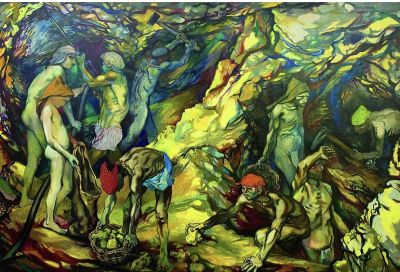After viewing the documentary film, “La Porta dell'Inferno” (“The Door to Hell”) by Michael Cavalieri, I felt compelled to delve deeper into the history of the Sicilian sulfur mines and the zolfo (sulfur) workers from the end of the 1700s until they were closed for good in 1986. It is a heart-wrenching story of the inhumane working conditions, indentured servitude of mere children, and the deaths and crippling diseases wrought upon men and boys by the mine owners.
Large deposits of sulfur were found in central Sicily between the provinces of Caltanissetta, Enna, and Agrigento. Refineries and milling plants were in coastal towns such as Catania.
Sulfur was used for gunpowder in the 1700s and then for sulfuric acid, soda ash, and in agriculture to prevent powdery mildew on the grape crops. They mainly exported the sulfur to France and Great Britain. By the end of the 19th century, 90 percent of the world’s sulfur came from Sicily. At this time there were more than 800 mines and more than 30,000 workers.
In the early years, sulfur was extracted from the surface in open-pit mining. When that was exhausted the underground mines were built. Shafts and narrow tunnels were carved through the rock along with steps going down into the mountain that in larger mines could number up to 1,000.
Picuneri (pick-ax workers) extracted the ore and loaded it into containers. They each had two to four young boys (carusi, meaning “small child”) who would carry loads of ore weighing up to 110 pounds on their backs. The carusi were indentured servants “sold” to the overseers, from as young as 4-7 years old. They suffered abuse by the older workers who were themselves abused. Carusi were forced to travel up and down the uneven, slippery steps to the surface many times each day. The steps were so narrow and steep, sometimes at an 80-degree angle which could cause the young boys to fall and be injured. Donkeys would transport the ore to the ships for export until almost the end of the 19th century when small railways were made and workers hand-pushed the wagons filled with ore.
With temperatures in the mines being above 110 degrees and 100 percent humidity, the men and boys worked with nothing more than a leather strap covering their genitals. They worked many times from dusk until dawn under the demands of the overseers and the chief overseer. The larger mines required the workers to live in large barracks away from their families. The young boys would become barely recognizable to their families due to these inhumane working conditions and living away from home for long periods of time.
One account from a doctor who visited the antiquated mines documented the crippling effect on the workers’ spines, the cancers, the lung disease, the vision loss, and the inability to develop normally, such as thirty-year-olds whose height didn’t go beyond four feet. Worst of all were the mine collapses, gas explosions, and asphyxiation causing death to hundreds of workers, many of whom were never found or identified.
At the turn of the century, trade unions formed, and strikes were called to obtain more humane working conditions but this only led to clashes with the army and left countless dead.
Many things led to the closing of the mines. Beginning in 1975, various labor laws were passed but the main reason was that Sicily, due to the different conformation and composition of the sulfur deposits, could no longer be competitive with the mining process used in the U.S. which drastically lowered the cost of extraction. The Sicilian mines were forced to close.
More than two centuries of this exploitation became the subject most touched upon by poets, writers, musicians, and storytellers, who wrote and sang of the torment and despair endured by the sulfur mine workers. The 1958 Gessolungo mining disaster inspired a song “La Zolfara”, made famous in 1961 by Ornella Vanoni. A painting by the same name was created in 1953 by the artist Renato Guttuso. It is a striking painting which captures the inside of a sulfur mine and the men and children who worked in it.
What these men did to support their families when they felt they could not do any other work, whether due to lack of education or not being able to leave the family, is still unfathomable to me, especially what was done to the carusi. When some were finally able to emmigrate to the U.S. many ended up working in coal mines since this was their only occupational experience.
https://www.lagazzettaitaliana.com/history-culture/10307-hell-on-earth-the-sulfur-mines-of-sicily#sigProId93ada52d99




